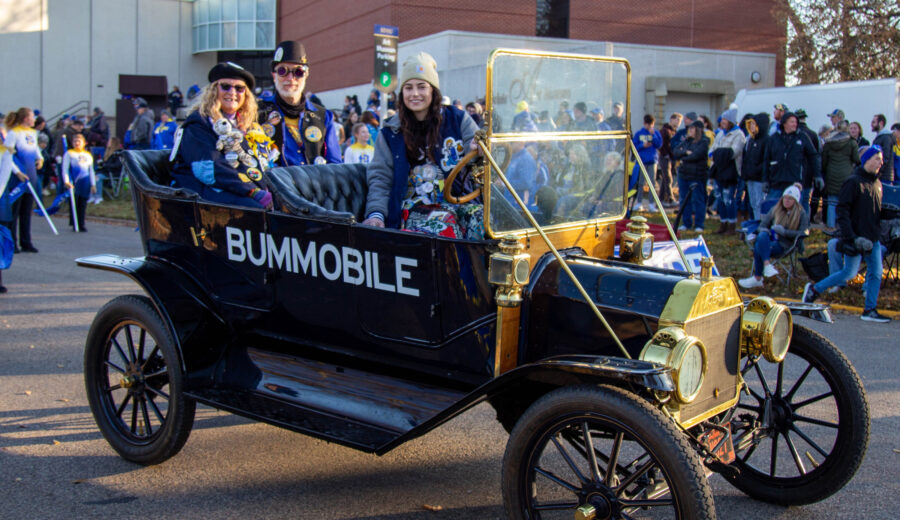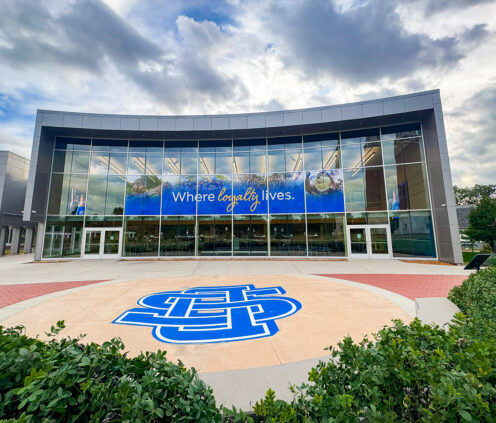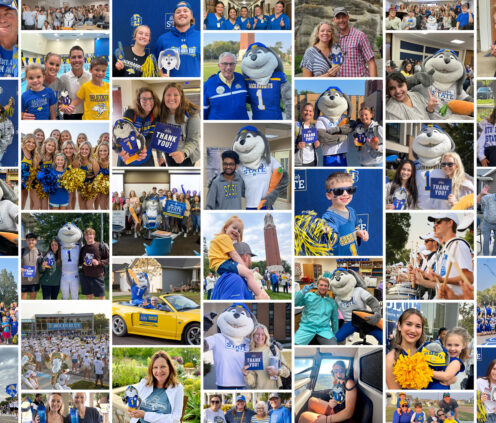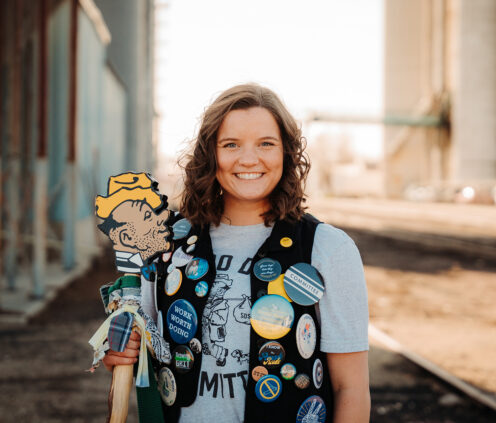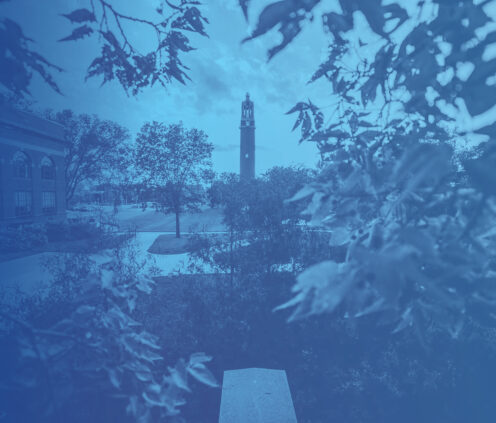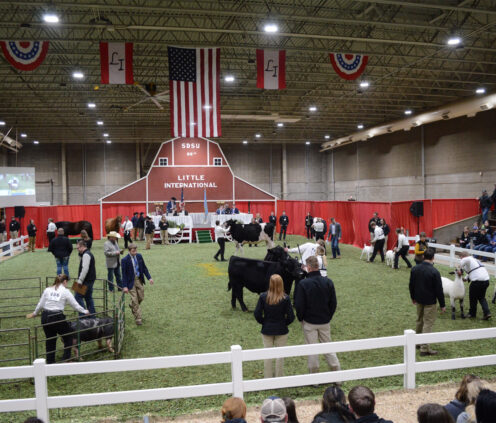Bummobile Chugs Along as SDSU’s Timeless Tradition
The university’s iconic Model T has a storied past and a Hobo-filled future.
The road to becoming a tradition is often paved by unforgettable stories, and while SDSU’s Bummobile is a symbol of nostalgia and Jackrabbit spirit, the story behind the iconic Model T Ford reads more like the plot of an action movie: its history includes theft, fire, and running over people, just to name a few noteworthy anecdotes.
The revered automobile that ushers in the parade each year has reached the 110th anniversary since it was first manufactured. Though the Bummobile bears no odometer, it’s come a long way since it was introduced into SDSU’s homecoming celebration, and the journey to becoming one of the university’s timeless traditions is nothing short of Hobo magic.

While it’s unknown where the Bummobile got its name, its origin to SDSU can be traced back to Frank Weigel, a farmer from Flandreau, South Dakota. Weigel wasn’t an alum of the university and had little known connections to State. Despite that, he’d make a donation in 1938 that would shape the future of Hobo Day. Weigel’s own Model T Ford, already 26 years old at the time, was manufactured in 1912. He knew that SDSU’s homecoming celebration had originated in the same year, and in true Midwestern farmer spirit, felt that someone else could find value in his old car. Weigel’s only condition in sharing his automobile with South Dakota State was that he receive a photo of the Hobo Day King and Queen sitting in it.
Needless to say, the tradition stuck. Before the Bummobile made its way to SDSU, the Hobo Day celebration used a mule-drawn carriage to transport university figures. The Model T was an instant upgrade, and Jackrabbit students eagerly made the car an integral part of the festivities, even forming traditions for the Bummobile itself.
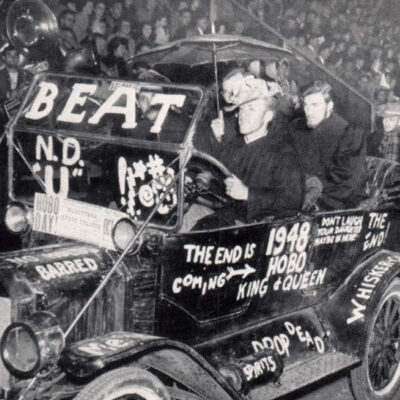


Until 2014, it was common practice for the yellow and blue community to tap into their creative sides and paint the car in honor of the year’s homecoming theme.
A more uncommon practice was the distinguished honor of being run over by the Bummobile. Yes, you read that right: for generations, Hobos would lie head to foot, end to end, vertically down Medary Avenue, testing the clearance of the Bummobile as it chugged over a seemingly endless lineup of Jackrabbits.

Though the practice was discontinued around 2016, SDSU creativity abounds, and it’s never too late for the Bummobile to lead the way toward new traditions – but above all, the greatest Bummobile tradition is its unfailing presence at the grandest one-day event in the Dakotas.
Since 1939, it has been a fixture in every parade, kicking off the first lap with Weary Wil and Dirty Lil before looping back with the current Grand Pooba, along with the Hobo Day Committee in tow. With the exception of the 1942 World War II fallout and the 2020 global pandemic, the Bummobile has made an appearance at every homecoming.

As stewards of the Bummobile and its maintenance, the Hobo Day Committee often cites their mission to ensure the car is a part of the Hobo Day Parade, whether it is “pushed, pulled, or drug” – and the Committee means it, having pushed the Bummobile through the parade route on multiple occasions. (Thankfully, its original vanadium alloy steel makes for a light push.)
Though the Bummobile is most known for its sojourns outside its resting place of the Hobo Day Gallery strictly on Hobo Day itself, it’s racked up plenty of miles and milestones outside of homecoming week.
In 1952, the Model T would even seat a future United States president. Working his way along the campaign trail, Dwight Eisenhower found himself on the SDSU campus and engaged in a photo op with the Bummobile. The photo was later published in The Collegian, where staff would cheekily caption the moment with, “Ike Reaches Peak in Career”. The student writers were wrong on both counts: the photograph wasn’t the peak of Eisenhower’s career, nor the Bummobile’s.

In the 1960s, the car gained the lay of the land throughout South Dakota as the Hobo Day Committee trekked around the state, selling Hobo Day merchandise and buttons in fundraising efforts. Up until the dawn of social media, this was a primary method for boosting resources for the Hobo Day celebration. (Nowadays, it’s much easier to support Hobo Day and the Bummobile by making a gift online.)
help support the hobo day tradition
Scandal struck the Bummobile in 1971 when the car was stolen by the University of South Dakota in an act of school rivalry. On the Thursday prior to that year’s Hobo Day celebration, USD’s Alpha Tau Omega fraternity took the Bummobile from the Hobo Day Committee’s garage, towing the vehicle all the way back to Vermillion. After receiving a frantic phone call from a sorority housemother who noticed the 60-year-old vehicle parked on the USD lawn, several Hobo Day Committee members raced south to reclaim the car. Vermillion police became involved, issuing a $350 citation to the fraternity for the theft. The bill did not initially include the cost of repairs to the Bummobile, which had been damaged in the towing due to the fraternity’s failure to take the vehicle out of gear.
Loren Haufschild, Bummobile and Booster Trip Chairman at the time, managed to restore the Bummobile to “partially operative condition” in time for the 1971 Hobo Day Parade, but local lore tells of multiple acts of sabotage on the Model T from USD. As Chuck Cecil confirmed in a 2011 article for STATE magazine, “There are at least two documented and well-executed thefts of the car, followed by red-faced confessions from interlopers residing at a lesser university to the south.” Yet despite rival universities’ best efforts, the Bummobile continues to Hobo on in each homecoming parade.
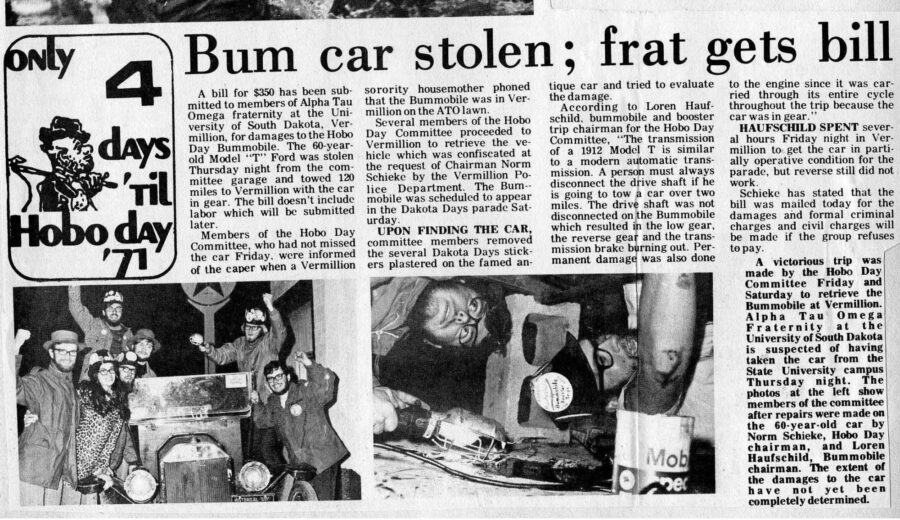
After the USD thefts, the Bummobile lived a relatively quiet existence, aside from its annual Hobo Day jaunt…and the few occasions where it has caught on fire, including a smoky episode during the Foundation’s 2018 One Day for STATE Yellow and Blue Block Party. Much like any relic from over 100 years ago, the automobile is subject to its mechanical hiccups, and in response, the Hobo Day Committee has stashed two fire extinguishers under the backseat in case of emergency, doubling down on the motto to push, pull, drag, or in this case extinguish, the Bummobile.
As stewards in charge of the car’s wellbeing, safety standards, and aesthetic appeal, the Committee undergoes extensive training to earn the right to drive the Bummobile, as well as the right to determine when the automobile is in need of upgrades.
Quality upgrades were a decision the Committee was faced with by the 2000s. After countless parades, publicity stunts, and journeys around the state, the Bummobile was beginning to show its age – the original black paint was dull and fading, while the steel materials that had optimized its light weight in the 1900s made for an overly-pliable frame that was easily bent and subject to rust.
In 2009, a 1943 electrical engineering alum, Harold Hohbach, debuted his own remodeled 1911 Ford Model T pickup in the Hobo Day Parade. Along with the Hobo Day Committee, university and Foundation officials took note of Hohbach’s fine craftsmanship and attention to detail, inquiring if he’d be interested in working his magic on the Bummobile.
Hohbach needed little convincing, whisking SDSU’s beloved buggy away to Palo Alto, California for restorations – the furthest from “home” the car had ever traveled. Along with the help of his employee, Hensel Troche, and key funding from alum Jerry Lohr, Hohbach restored the Bummobile’s paint to its original midnight blue, adding black hues to accent the car’s fenders and running boards.
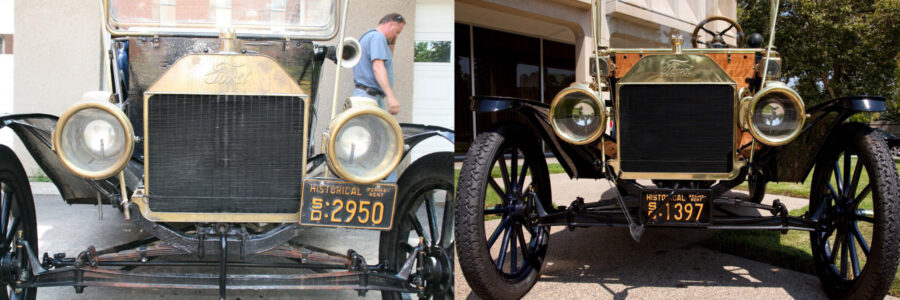
Thanks to Hohbach’s work, the Bummobile is primed to drive through countless Hobo Days to come. It represents not just nostalgia or school spirit, but embodies lessons and values that speak to the Jackrabbit way of life.
In Weigel’s generosity, we see the impact of philanthropy and the ripple effects of a culture of giving.
In the Bummobile’s wilder chapters, we see the unique history and evolution of our university, which never fails to keep moving forward.
In the car’s enduring presence on Hobo Day, there’s a reflection of State’s resilience, grit, and dedication to upholding the traditions we hold dear.
The Bummobile is much more than just a car; it’s a four-wheeled reminder of what makes SDSU a place unlike anywhere else.
